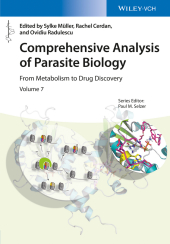 Neuerscheinungen 2016Stand: 2020-02-01 |
Schnellsuche
ISBN/Stichwort/Autor
|
Herderstraße 10
10625 Berlin
Tel.: 030 315 714 16
Fax 030 315 714 14
info@buchspektrum.de |

Rachel Cerdan, Ewelina Guca, Sylke Müller, Ovidiu Radulescu, Paul M. Selzer
(Beteiligte)
Comprehensive Analysis of Parasite Biology
From Metabolism to Drug Discovery
Herausgegeben von Müller, Sylke; Cerdan, Rachel; Radulescu, Ovidiu; Guca, Ewelina; Selzer, Paul M.
1. Auflage. 2016. XXIV, 548 S. 244 mm
Verlag/Jahr: WILEY-VCH 2016
ISBN: 3-527-33904-3 (3527339043)
Neue ISBN: 978-3-527-33904-4 (9783527339044)
Preis und Lieferzeit: Bitte klicken
Dieses Buch, geschrieben von Fachexperten auf dem Gebiet, fasst den aktuellen Stand der Wissenschaft im Hinblick auf phänotypische und zielorientierte Ansätze der Entwicklung von Arzneistoffen gegen pathogene Protozoen zusammen. Der Schwerpunkt liegt dabei vor allem auf virtuellen Substanzen und dem Hochdurchsatz-Screening, auf Naturprodukten, dem computergestützten Design von Arzneistoffen, dem strukturgestützten Design von Arzneistoffen, der Identifizierung von Wirkmechanismen und dem Pathway-Modelling. Weiterhin werden moderne "omik"-Technologien sowie enzymatische Drug Targets erörtert. Mathematische, auf der Systembiologie basierende Ansätze werden als neue Methoden für die Auflösung komplexer Mechanismen, die Pathogene überleben lassen, und für die Target-Identifizierung vorgestellt. Präsentiert werden darüber hinaus neu entwickelte Wirkstoffe, die über bestimmte Pathways Parasiten abtöten und als Leitsubstanzen für weitere Arzneimittelentwicklungen dienen.
Written and edited by experts in the field, this book brings together the current state of the art in phenotypic and rational, target-based approaches to drug discovery against pathogenic protozoa. The chapters focus particularly on virtual compounds and high throughput screening, natural products, computer-assisted drug design, structure-based drug design, mechanism of action identification, and pathway modelling. Furthermore, state-of the art "omics" technologies are described and currently studied enzymatic drug targets are discussed. Mathematical, systems biology-based approaches are introduced as new methodologies for dissecting complex aspects of pathogen survival mechanisms and for target identification. In addition, recently developed anti-parasitic agents targeting particular pathways, which serve as lead compounds for further drug development, are presented.
Discovering the mechanism of action of novel compounds that target unicellular eucaryotic parasites
Contribution of Natural Products to drug discovery in tropical diseases
Isoxazolines as effective ectoparasiticides
Trypanosomal Cysteine Proteases: Target Validation and Drug Design Strategies
Potential of pyrimidine metabolism for antitrypanosomal drug discovery
The Kennedy pathways for phospholipid biosynthesis in Plasmodium
Immunophilins as possible drug targets
Autophagy in Plasmodium/invasion of Plasmodium
The glideosome: the locomotive complex behind gliding motility and invasion
Turnover of glycosomes in trypanosomes. Perspectives for drug discovery
N-myristoyltransferase as a target for Drug Discovery in Malaria
Intermediary carbon metabolism of Plasmodium revisited
The role of metabolomics in antiparasitic drug discovery
Methods to investigate system biology in Trypanosoma
The importance of targeting lipid metabolism in parasites for drug discovery
Epigenetic gene regulation: a key to development and survival of malaria parasites
Emerging importance of t-RNA synthetases as anti-malarial drug targets
Understanding protozoan parasite metabolism and identifying drug targets through flux balance analysis
Attacking blood-borne parasites with mathematics
Kinetic modeling of metabolism and drug target identification in Apicomplexa
Antiparasitics from algae
Mechanisms regulating transcription in Plasmodium falciparum as targets for novel antimalarial drugs


